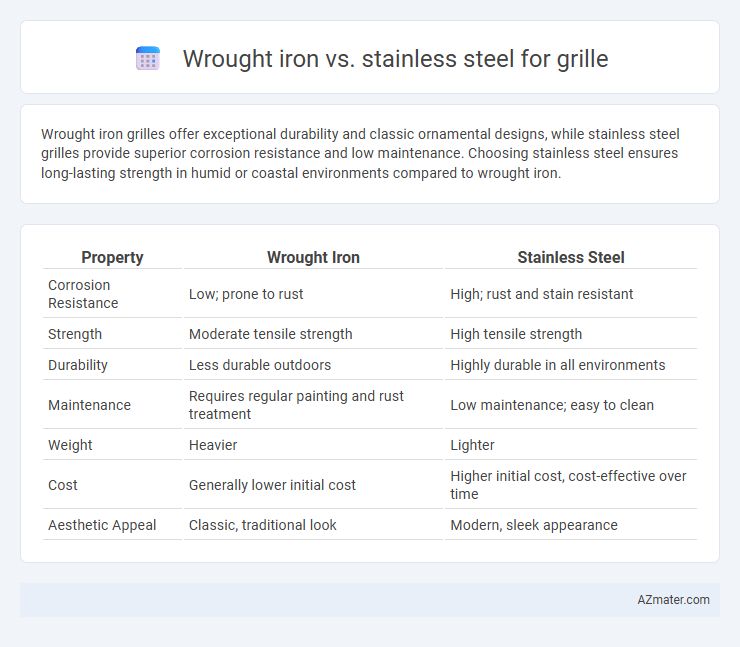Wrought iron grilles offer exceptional durability and classic ornamental designs, while stainless steel grilles provide superior corrosion resistance and low maintenance. Choosing stainless steel ensures long-lasting strength in humid or coastal environments compared to wrought iron.
Table of Comparison
| Property | Wrought Iron | Stainless Steel |
|---|---|---|
| Corrosion Resistance | Low; prone to rust | High; rust and stain resistant |
| Strength | Moderate tensile strength | High tensile strength |
| Durability | Less durable outdoors | Highly durable in all environments |
| Maintenance | Requires regular painting and rust treatment | Low maintenance; easy to clean |
| Weight | Heavier | Lighter |
| Cost | Generally lower initial cost | Higher initial cost, cost-effective over time |
| Aesthetic Appeal | Classic, traditional look | Modern, sleek appearance |
Introduction: Wrought Iron vs Stainless Steel Grille
Wrought iron grilles offer classic elegance and exceptional strength, making them ideal for traditional architectural styles and security purposes. Stainless steel grilles deliver superior corrosion resistance and low maintenance, suitable for modern, industrial designs exposed to harsh weather conditions. Choosing between wrought iron and stainless steel depends on desired aesthetics, durability requirements, and environmental factors influencing longevity.
Material Composition and Properties
Wrought iron grilles consist primarily of nearly pure iron with low carbon content, providing excellent malleability and tensile strength, making them ideal for decorative and intricate designs. Stainless steel grilles are composed of iron alloyed with at least 10.5% chromium, delivering superior corrosion resistance, higher durability, and low maintenance compared to wrought iron. The chromium oxide layer in stainless steel prevents rust, while wrought iron requires regular treatment to avoid oxidation and maintain structural integrity.
Durability and Strength Comparison
Wrought iron grilles exhibit exceptional strength due to their solid and malleable composition, providing superior resistance to bending and physical damage. Stainless steel grilles offer enhanced durability through corrosion resistance, maintaining structural integrity even in harsh weather conditions or exposure to moisture. Comparing both, wrought iron excels in impact strength while stainless steel outperforms in longevity and low maintenance requirements.
Aesthetic Appeal and Design Versatility
Wrought iron grilles offer a classic, ornate aesthetic with intricate patterns that enhance traditional and vintage architectural styles. Stainless steel grilles provide a sleek, modern look with smooth finishes that suit contemporary and minimalist designs. Both materials allow for customization, but stainless steel excels in offering a wider range of shapes and sizes due to its lightweight and durable properties.
Maintenance Requirements
Wrought iron grilles require regular maintenance including cleaning, rust prevention with protective coatings, and periodic repainting to avoid corrosion and maintain their aesthetic appeal. Stainless steel grilles offer superior resistance to rust and corrosion, requiring minimal maintenance primarily involving occasional cleaning to retain their polished finish. The long-term durability and low upkeep of stainless steel make it a more cost-effective option for maintenance-conscious applications.
Corrosion and Weather Resistance
Wrought iron grilles exhibit moderate corrosion resistance but require regular maintenance such as painting or sealing to prevent rust, especially in humid or coastal environments. Stainless steel grilles offer superior corrosion resistance due to their chromium content, forming a passive layer that protects against rust and withstands harsh weather conditions without frequent upkeep. Choosing stainless steel ensures long-term durability and minimal weather-related deterioration compared to wrought iron.
Security Features and Protection
Wrought iron grilles offer superior security features due to their high tensile strength and resistance to bending, making them difficult to break or deform. Stainless steel grilles provide excellent protection against corrosion and rust, ensuring long-lasting durability in various weather conditions without compromising structural integrity. Both materials enhance security, but wrought iron is often preferred for heavy-duty protection, while stainless steel excels in low-maintenance, rust-resistant applications.
Cost Analysis and Budget Considerations
Wrought iron grilles typically incur higher initial costs due to labor-intensive fabrication and custom design elements, while stainless steel options generally offer lower upfront prices with mass-produced availability. Maintenance expenses for wrought iron increase over time because of susceptibility to rust and regular painting, whereas stainless steel requires minimal upkeep, lowering long-term costs. Budget considerations must balance initial investment against durability, with stainless steel favored for cost-effective longevity and wrought iron chosen for aesthetic value despite higher maintenance expenses.
Environmental Impact and Sustainability
Wrought iron grilles typically have a higher environmental impact due to energy-intensive smelting and forging processes, while stainless steel benefits from more efficient recycling and lower lifecycle emissions. Stainless steel grilles offer greater sustainability as their corrosion resistance prolongs lifespan and reduces the need for frequent replacement or maintenance coatings. The recyclability rate of stainless steel exceeds 90%, making it a more eco-friendly choice compared to wrought iron, which often requires significant energy input during fabrication.
Choosing the Right Material for Your Grille
Wrought iron grilles offer classic elegance, superior strength, and easy customization, making them ideal for decorative security and traditional aesthetics. Stainless steel grilles provide exceptional corrosion resistance, low maintenance, and modern appeal, perfect for outdoor and coastal environments where durability against rust and weathering is critical. Selecting between wrought iron and stainless steel depends on your priorities for design, longevity, and environmental exposure to ensure the best fit for your grille needs.

Infographic: Wrought iron vs Stainless steel for Grille
 azmater.com
azmater.com